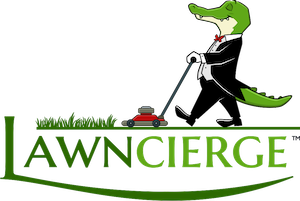Mulch in South Florida
Using mulch is an important part of keeping your lawn and yard looking its best. A layer of mulch around trees, shrubs, and plant beds provides many benefits. In areas that are difficult to mow, irrigate, or otherwise maintain, use mulch to replace turf or ground covers. Mulch may also be a good choice for shady areas where many plants don’t grow well.
If you decide to mulch your lawn and landscape, reach out to Lawncierge for all your mulch needs. We can help you choose the right mulch that both promotes the health of your plant beds, trees, and lawns and maximizes the natural beauty your landscape and your home.
Why should I mulch?
Mulch is a healthy addition to any landscape, because it buffers soil temperature which is important through the hot Florida summers. Mulch keeps soils and plant roots warmer in winter and cooler in summer. Mulch also helps in maintaining soil moisture by slowing evaporation and reducing the water needs of plants. This is especially helpful if your lawn or surrounding plants have higher water requirements or are less draught tolerant.
Aesthetically, mulch also inhibits weed germination and growth. This can help make your lawn and yard look beautiful and weed-free. Mulch gives plant beds a neat and uniform appearance and its color and texture can complement plantings. This actually helps to protect plants. Mulch prevents certain plant diseases when placed around shrubs and trees.
Mulching helps with your yard’s soil. It can reduce soil erosion, and as it decomposes organic materials like wood chips, pine needles, leaves, and grass clippings make soil more fertile and improve soil aeration, structure, and drainage. It’s also possible mulching is done for you
What should I look for when choosing mulch?
There are several factors to consider when selecting mulch for your landscape and lawn. Depending on your goals and what you are looking to achieve, you might want to consider the following:
- Cost – Mulch varies in cost depending on the time of year and the region. Buying mulch in bulk is one strategy to reduce price, so choosing to mulch at a popular time may reduce costs as lawn care providers can purchase in greater quantities and pass the savings on to their clients.
- Color – While color may be an after though based on other factors you choose, you may want to consider how the color of the mulch will complement the plants in your landscape and lawn.
- Origin – Do you know where your mulch is being sourced from? Locally sourced mulch has a lower risk of containing invasive bugs or decomposing into nutrients incompatible with the plants in your landscape and lawn.
- Durability – How well does the mulch hold up over time? Will you need to consider replacing the mulch annually or semi-annually?
- Nutrient content – As mulch breaks down it can provide a healthy nutrient base for the plants in your landscape. Better nutrient content leads to healthier plants and a more beautiful lawn.
- Texture/Appearance – Does the mulch match the aesthetic of your landscape, or will it look out of place?
Which mulch should I choose?
There are several different kinds of mulch available and often used in South Florida. Each type of mulch has its pros and cons:

- Pine Bark – A byproduct of the forestry industry, pine bark comes in ground form or nugget form and has a rich brown color. Pine bark is a very long lasting type of mulch but doesn’t offer as much nutrient content to plants as it breaks down.

Pine Straw – Pine straw, or pine needles, come from pine tree plantations which make wood and paper products and is usually sold in bales. Pine needles are less likely to wash away because of how they knit together.

Fallen leaves – Fallen leaves and grass clippings can often be found on your own property and just need to be raked up and put into place. This type of mulch is high in nutrient content but as such it breaks down quickly and needs to be replaced often.

Melaleuca Mulch – Made from the invasive melaleuca tree, this mulch is cooked as a high temperature to ensure no seeds survive and the species doesn’t continue to propagate across <PLACE_NAME>. Melaleuca mulch is a long lasting mulch but doesn’t provide as many nutrients to plants as it decomposes.

Mixed Hardwood – Often produced from scrap lumber, recycled pallets, or tree stems and trunks otherwise unusable for paper or wood products, mixed hardwood can be a popular choice for landscaping.

Eucalyptus Mulch – Eucalyptus is popular in South Florida because it comes from plantations from Central and South Florida where trees are grown from mulch. This allows locally sourced mulch which might reduce risk of invasive species and reduced transportation costs. These trees grow quickly and therefore is considered a renewable source of mulch.

- Utility mulch – Mulch that is sold or given away for free from utility companies. This comes from chips made from tree trimmings and other plants that utility companies clear from power lines. One should be cautious as this may come with weed seeds which could propagate across your lawn.

- Cypress Mulch – Comprised of both wood and bark of cypress trees that grow in Florida’s wetlands. These trees are often harvested for lumber for fencing, flooring, furniture and other wood products, where the waste byproducts can be used for mulch. Mulch may be made from waste products or from whole trees harvested directly for this purpose.
Cypress, melaleuca, and pine bark are typically the longest lasting types of mulch but don’t offer plants as many nutrients when they break down. Pine bark and pine straw may reduce the pH (increase the acidity) of soil as they break down which is good for some plants like azaleas but not others.
How should I use mulch?
The following are helpful guidelines when applying mulch to your landscape:
- Mulch should be applied and maintained in a 2- to 3-inch layer around established trees, shrubs, and bedding plants. You can apply coarser materials such as pine to a depth of 4 inches but you shouldn’t allow mulch to accumulate to a depth greater than 4”. Adding more mulch can harm plants as mulch blocks rain and irrigation which could otherwise be used for plants’ root systems.
- Try to avoid piling mulch against the base of a tree, sometimes called “volcano mulching”. This holds moisture encouraging rot in the trunk of the tree. Mulch piled against the trunks of young trees may also create habitats for rodents that chew the tender bark and can ultimately kill the trees.
- Mulch to the drip line or beyond. The mulched area around trees should be at least 8 feet in diameter. Remember that in a forest environment, a tree’s entire root system – which usually extends well beyond the drip line – would be naturally mulched.
- Rake out old mulch. Some mulches can become matted, which prevents water and air from getting through. Rake it to benefit plantings and refresh the mulch’s appearance.








